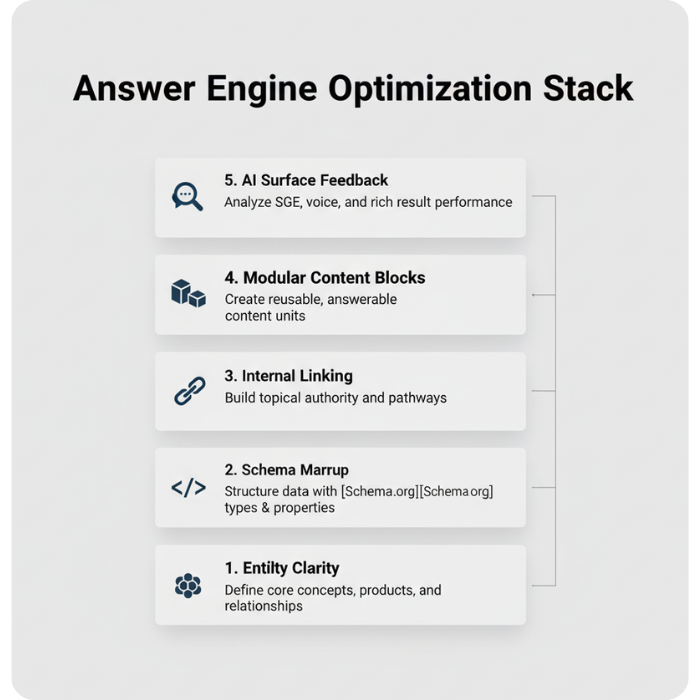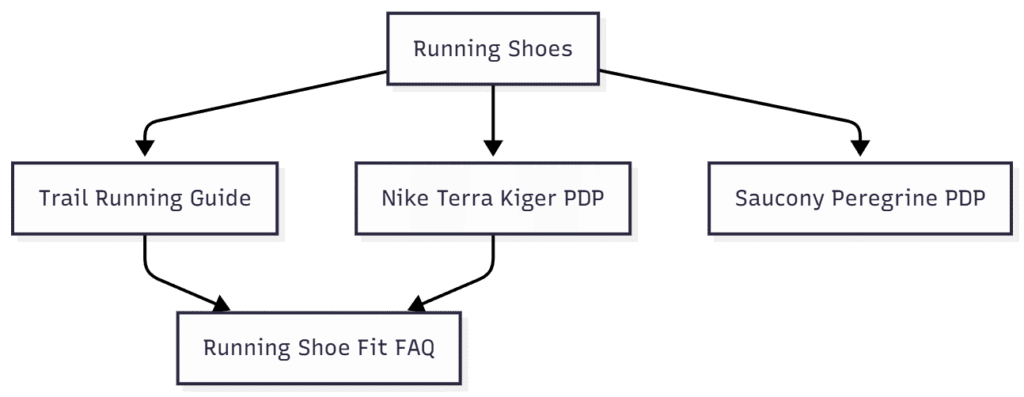From Keywords to Entities
Keyword targeting used to be the backbone of SEO: match searcher intent with exact phrases, rank higher, get traffic. But AI systems don’t process content as strings. AI parses it as things. That shift from keywords to entities is more than semantic, it’s structural.
Google, Bing, and now AI-powered surfaces like Search Generative Experience (SGE) rely on knowledge graphs, not just index lists. That means what matters isn’t whether you included “best wireless earbuds 2025”—it’s whether your content clearly represents the product as an entity that relates to brand, category, use case, and features.
This is why sites with clean taxonomy, explicit naming, and structured metadata outperform keyword-heavy content. Even with fewer backlinks or lighter copy.
Entity-first search treats your site like a map of meaning, not just a bag of phrases. The algorithm isn’t just asking, “Does this page use the right terms?” It’s asking, “Does this page help me understand what this product is, how it relates to other things, and how confidently I can use it in an answer?”
If your PDP or blog post doesn’t clarify:
- What entity it represents (Product, Category, Topic)
- How it relates to other entities (via internal linking and semantic cues)
- Whether it’s canonical, specific, and answerable
…you’re likely excluded from generative results—even if you “rank.”
But entity-based SEO is not just about structured data (yet)—we’ll get there in the next section. It starts with clarity in your language and structure:
- Use consistent naming conventions across products, categories, and internal content
- Avoid vague or mixed-topic page titles
- Cluster supporting content around entities—not just funnel stages
You’re not optimizing for phrases anymore. You’re building clarity for machines. Because in entity-first search, recognition beats ranking.

Schema as the New SEO Surface
If entity clarity gets you into the conversation, schema gets you into the results.
Structured data used to be a technical nice-to-have—an enhancement for rich snippets or product reviews. But with AI-generated search (SGE), voice interfaces, and zero-click SERPs as the new normal, schema becomes the primary interface between your site and the machine’s output layer.
Google isn’t “reading” your content. It’s parsing structured metadata. If your product, blog post, or category page isn’t marked up with schema.org tags that define what it is, who it’s for, and how it should be interpreted—it’s either invisible or misrepresented in generative results.
AI surfaces don’t return blue links. They return answers. To show up as part of those answers—pulled into AI summaries, answer panels, or product carousels—your content needs to be machine-extractable.
Here’s what that actually means in practice:
- Product schema (with GTIN, brand, price, availability, aggregateRating)
- FAQ/HowTo schema (for tutorial content or support workflows)
- Organization/Author schema (to establish trust and identity in AI summaries)
- Article schema (for content structured as informational assets)
And it’s not just Google—Pinterest, TikTok, Meta Shops, and Amazon all depend on structured product data, whether it lives in a feed or a PDP.
Schema is no longer a “markup” layer—it is the surface that AI reads.
Your content strategy has to account for this at the planning level:
- What schema types do your core pages support?
- Are those types consistently implemented across templates?
- Are you using tools like JSON-LD or GoDataFeed to enrich PDPs and feeds in real time?
If your content isn’t structured, it’s not searchable—at least not in the way modern platforms define “search.”

Building for Answerability, Not Just Ranking
High rankings don’t mean what they used to. In generative search environments, being #1 doesn’t guarantee you’ll be seen, let alone used. What matters now is whether your content can be lifted, cited, or synthesized directly into an AI-generated answer.
This is the new bar: answerability.
SGE doesn’t just display search results—it constructs responses from the content it deems usable. That means your content needs to be structured for fast parsing, semantic clarity, and modular integration. If your page has the right answer but buries it in 600 words of fluff, you’ve already lost.
AI search engines don’t just evaluate what you say—they evaluate how easily they can extract and trust it.
That means:
- Short, structured answer blocks (think: TL;DRs, definition boxes, feature lists)
- Headings that mirror questions or topical prompts
- Semantic proximity between entities, actions, and outcomes
- Zero ambiguity in who said what, especially for quotes, stats, or product claims
And it’s not just copywriting. Content hierarchy and layout matter:
- Use semantic HTML (not just styled divs)
- Place high-signal answers above the fold
- Avoid generic filler text or templated intros—AI ignores them
You’re not just writing for users anymore. You’re designing for AI readability and answer extraction.
Think of your content like a structured FAQ—where every section has to justify its inclusion in a machine-generated response. If your site isn’t answerable, it’s ignorable.

Product Pages as Structured Entities
Your PDP isn’t just a sales page—it’s a data object. And in AI-driven search and commerce platforms, that distinction determines whether your product gets surfaced—or ignored.
When Google, Meta, or Amazon parses a product page, it’s not reading like a user. It’s crawling for entity definitions: What is this? What category does it belong to? How does it compare? Is it reliable? Can I quote it?
This is why incomplete PDPs tank your visibility even if your products are competitively priced, well-reviewed, or in-stock.
Modern PDPs must function like mini knowledge graphs. They need to define:
- The product entity (with schema.org/Product and unique identifiers like GTIN, MPN, brand)
- Relationships to categories, use cases, variants, and bundles
- Structured user-generated content (e.g. review schema, Q&A markup)
It’s not just about accuracy but also about eligibility:
- No GTIN? You’re out of Google Shopping.
- No structured review data? You won’t show in AI overviews with social proof.
- No defined category path? Your listing is harder to cluster, recommend, or compare.
And it goes beyond search. Meta’s Advantage+ Catalog Ads, Pinterest product pins, and TikTok Shops all rely on structured PDP data to personalize and rank inventory in real-time.
If you treat PDPs as static landing pages, you’re playing by 2015 rules.
Today, your product page is a machine-readable object that must broadcast its identity, attributes, and credibility to dozens of AI systems. That means:
- Structured schema on every PDP
- Feed consistency between site data and merchant centers
- Content hierarchy that supports AI summarization (benefits → specs → reviews → related)
AI doesn’t “figure it out.” It picks the cleanest, clearest object—and moves on.
Internal Linking and Context as Entity Scaffolding
To a search engine, your internal links are more than navigation—they’re contextual signals that map out how your site defines and connects entities. AI doesn’t just index pages individually—it builds a graph of relationships.
That means your internal linking structure isn’t just a UX decision. It’s part of your entity architecture.
Entity-first search engines want to know:
- How is this concept related to others?
- Is this page an authority on this entity—or just referencing it?
- What other trusted content supports or expands it?
Links are how you answer that.
For example:
- Linking your “running shoes” category page to guides on “trail running,” “pronation types,” and “sock fit” reinforces the semantic field around the product entity.
- Supporting PDPs with comparison charts, FAQ pages, and blog content signals topical authority.
- Clustering product accessories or compatible items builds entity webs that platforms like Google and Meta can ingest and rank.
The logic is: links = reinforcement. No links = isolation. Even a well-optimized page can be contextually orphaned if it’s not linked into a topical graph.
You’re not just building site architecture—you’re training the algorithm on entity relationships.
- Create content clusters around high-value products, categories, or problems
- Link horizontally between guides, PDPs, and FAQs—not just downward in the hierarchy
- Use consistent anchor language tied to the entity being reinforced
These are the essentials for semantic relevance in an AI-indexed ecosystem. Because in modern SEO, context is the currency of credibility.

AEO is the New SEO
Search Engine Optimization is no longer enough. We’re now optimizing for Answer Engines—AI systems that synthesize, not just index. In this new world, visibility depends less on traditional ranking signals and more on whether your content can be used by machines to construct a response.
This shift from SEO to Answer Engine Optimization (AEO) means your KPIs, page structure, and measurement frameworks all need to evolve.
The goal is not just getting traffic, it’s getting trusted by the machine.
In a zero-click environment:
- The highest “ranking” content may not receive a single visit—it’s quoted, not clicked.
- Your FAQ might power a voice assistant answer, without showing up in your traffic report.
- Your PDP data may fuel product carousels or comparisons, but never trigger a direct session.
So how do you track impact?
You monitor:
- Inclusion in AI surfaces (via tools like SGE visibility audits or merchant center diagnostics)
- Answer block usage (especially from structured FAQ, HowTo, and review content)
- Content lift metrics like brand mention in AI summaries or co-citation frequency
And more importantly—you align your content strategy around answerability and machine utility, not just SERP rank or CTR.
SEO isn’t dead. It’s evolved. What we used to call SEO now has a new job: supplying data, structure, and clarity to AI engines trained to answer, not just serve links.
So if you’re still tracking rank and hoping for clicks, you’re managing lagging indicators. The leading metric is this: Does your content help the machine answer the question?
If it does, you won’t just get seen, you’ll get used. And in an answer-first internet, that’s the difference between presence and preference.



